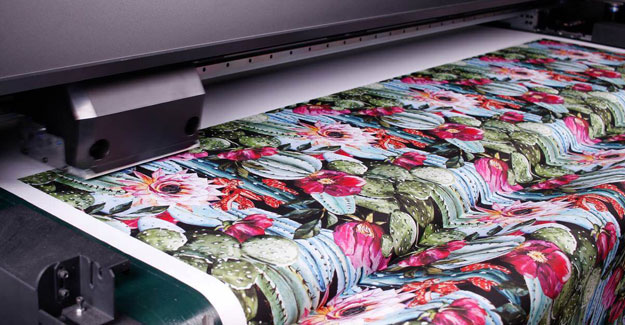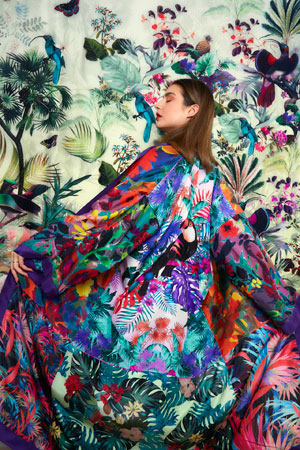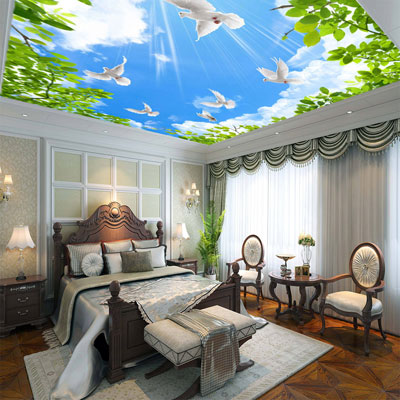
UV Print Innovations Are Perfect For The Décor Industry
Statistics show that the UV printing market is growing fast. The global market size is expected to reach US$ 1.71 billion by 2027 from US$ 0.35 billion in 2019, growing at a CAGR of 21.7% from 2020 to 2027. The market for UV cured printing inks is forecasted to reach US$ 1,600 million by 2026, registering a CAGR of 4.64%, during the period. The global UV LED print machine market (across multiple applications) reached US$ 278 million in terms of size in 2017 and is expected to reach US$ 555 million by the end of 2024, expanding at a CAGR of 9.2% over the forecast period.
As a sector, décor offers the industry an exclusive marketplace that is prime for disruption. UV technologies can unlock previously impossible surface effects and infinite creative applications. As the technology becomes ever more efficient, its green credentials also offer a sustainable printing process for personalised or industrial printed décor production.
"State-of-the-art UV inkjet print technology provides great versatility and a high ROI while leaving a small ecological footprint. By constantly adding new features and possibilities, swissQprint supports print service providers on their way to success and growth," said Erskine Stewart, Managing Director, swissQprint UK.
"The scope of UV wide format printing is enormous, and not a week goes by where we don't discover new and innovative applications created by our customers. What we have seen in recent years is a significant step change in efficiency both in terms of productivity and cost whilst maintaining all aspects of flexibility that are so crucial in this market. Our aim at Agfa is to push the boundaries of print quality at ever greater productivity, and we believe that our latest generation of printers and presses do just that, from entry level to industrial high end. They all cure with UV LED modules, they all produce equal high-quality prints, and they all use significantly less ink thanks to our patented Thin Ink Layer technology," said Bobby Grauf, Agfa UK.
 A very resource efficient printing technology
UV LED printing is energy efficient, contains no VOC's and delivers outstanding print quality. With its high peak irradiance UV provides a deeper penetrating light source. This enables better through cure and adhesion of thicker films (such as screen printing) and dark and opaque colours (such as blacks and opaque whites). Additionally, UV LED cures at a constant intensity over a long period of time, contrary to mercury lamps which need to be replaced every 2000 hours.
How UV LED printing works
In UV digital printing, after leaving the piezo-electric printhead the print dot sits on top of the media where it is cured by an Ultra-Violet light unit, and it dries immediately. This is because the LED light spectrum reacts with photo-initiators in the photo-chromic ink causing instantaneous drying and adhesion. As a non-contact instant dry print process, with perfect adhesion, this allows the printing of a wide range of substrates.
The quick drying print-process also gives UV printing a typically fast turnround, because the dried media can be handled immediately. Additionally, because of its quick-drying quality, UV LED printing cures instantly - the dots of wet ink do not get a chance to spread out once printed, resulting in much finer detail in the printed graphic output.
The range of printable substrates that can be printed with UV/LED technology is truly breathtaking - polyester fabrics, dense board, acrylic panels, wooden doors and backlit displays are all part of the UV LED inventory of print media.
The other main pillar of the appeal is its efficient usage of resources. Ultra-violet LED technology brings energy savings, pollution prevention, significant waste reduction, and significant long term financial savings to the printing process. With no mercury in the lamp, there are no environmental or personal safety issues with LED drying, which is instantaneous, highly productive, and energy efficient.
In general, UV LED provides a 30-50% reduction in energy consumption to run the lamp and cooling system when compared with previous curing technologies, and with a light lifespan measured in tens of thousands of hours against the 1,000-2,000 hours for mercury vapour lights, there is also a substantial cost benefit to the technology.
Ultra-violet inks are free of VOC's and when compared to solvent inks, there are no toxins, which when combined with the minimal use of water and heat in the process, the effect on the environment is negligible.
Innovations - Launches and the future
A very resource efficient printing technology
UV LED printing is energy efficient, contains no VOC's and delivers outstanding print quality. With its high peak irradiance UV provides a deeper penetrating light source. This enables better through cure and adhesion of thicker films (such as screen printing) and dark and opaque colours (such as blacks and opaque whites). Additionally, UV LED cures at a constant intensity over a long period of time, contrary to mercury lamps which need to be replaced every 2000 hours.
How UV LED printing works
In UV digital printing, after leaving the piezo-electric printhead the print dot sits on top of the media where it is cured by an Ultra-Violet light unit, and it dries immediately. This is because the LED light spectrum reacts with photo-initiators in the photo-chromic ink causing instantaneous drying and adhesion. As a non-contact instant dry print process, with perfect adhesion, this allows the printing of a wide range of substrates.
The quick drying print-process also gives UV printing a typically fast turnround, because the dried media can be handled immediately. Additionally, because of its quick-drying quality, UV LED printing cures instantly - the dots of wet ink do not get a chance to spread out once printed, resulting in much finer detail in the printed graphic output.
The range of printable substrates that can be printed with UV/LED technology is truly breathtaking - polyester fabrics, dense board, acrylic panels, wooden doors and backlit displays are all part of the UV LED inventory of print media.
The other main pillar of the appeal is its efficient usage of resources. Ultra-violet LED technology brings energy savings, pollution prevention, significant waste reduction, and significant long term financial savings to the printing process. With no mercury in the lamp, there are no environmental or personal safety issues with LED drying, which is instantaneous, highly productive, and energy efficient.
In general, UV LED provides a 30-50% reduction in energy consumption to run the lamp and cooling system when compared with previous curing technologies, and with a light lifespan measured in tens of thousands of hours against the 1,000-2,000 hours for mercury vapour lights, there is also a substantial cost benefit to the technology.
Ultra-violet inks are free of VOC's and when compared to solvent inks, there are no toxins, which when combined with the minimal use of water and heat in the process, the effect on the environment is negligible.
Innovations - Launches and the future
 In September 2020, Direct Colour Systems announced the release of the UV-84DTS - a new 4' x 8' (120cm x 243cm) UV LED printer. Also, in September 2020 Epson announced its first UV LED flatbed digital printer.
The printer, offering up to 2.5 x 1.25m print capability, prints directly on to a wide range of substrates up to 80mm thick including acrylics, polycarbonates, PVC, aluminium, metal, polyester, foamboard, styrene, wood and stone. In November 2020, Mimaki launched their UJV100-160 which uses a low-cost UV ink "LUS-190" which cures immediately after being exposed to UV light, allowing a faster turnaround without the need for a degassing period after printing.
In February 2021 Agfa introduced the Jeti Tauro H3300 UHS LED, targeted at the high end of the sign and display market. This UV LED inkjet engine prints media up to 3.3 m wide in four or six colours at a speed up to 600 m²/h. Mutoh EMEA released it's Mark II Series UV LED Printers - featuring the use of Mutoh's next generation algorithm. In March 2021 swissQprint launched neon colours for UV printing giving a special glow to advertising and signage.
In April 2021 Mimaki announced the release of two new LED-UV large-format flatbed inkjet printers, the JFX600-2513 and the JFX550-2513. The new models are engineered for high speeds and high productivity and offer print service providers a broader range of applications thanks to a wider range of ink types and increased media flexibility.
As can be seen, the increasingly wide selection of machinery, software and inks for UV LED printing reflects the vibrancy of demand for what many see as the most versatile of all the digital print technologies. A broad-based, eco-friendly technology that allows the user to service multiple marketplaces. As technology continues to evolve, the opportunities for UV applications within the décor marketplace will continue to expand in the years ahead.
In September 2020, Direct Colour Systems announced the release of the UV-84DTS - a new 4' x 8' (120cm x 243cm) UV LED printer. Also, in September 2020 Epson announced its first UV LED flatbed digital printer.
The printer, offering up to 2.5 x 1.25m print capability, prints directly on to a wide range of substrates up to 80mm thick including acrylics, polycarbonates, PVC, aluminium, metal, polyester, foamboard, styrene, wood and stone. In November 2020, Mimaki launched their UJV100-160 which uses a low-cost UV ink "LUS-190" which cures immediately after being exposed to UV light, allowing a faster turnaround without the need for a degassing period after printing.
In February 2021 Agfa introduced the Jeti Tauro H3300 UHS LED, targeted at the high end of the sign and display market. This UV LED inkjet engine prints media up to 3.3 m wide in four or six colours at a speed up to 600 m²/h. Mutoh EMEA released it's Mark II Series UV LED Printers - featuring the use of Mutoh's next generation algorithm. In March 2021 swissQprint launched neon colours for UV printing giving a special glow to advertising and signage.
In April 2021 Mimaki announced the release of two new LED-UV large-format flatbed inkjet printers, the JFX600-2513 and the JFX550-2513. The new models are engineered for high speeds and high productivity and offer print service providers a broader range of applications thanks to a wider range of ink types and increased media flexibility.
As can be seen, the increasingly wide selection of machinery, software and inks for UV LED printing reflects the vibrancy of demand for what many see as the most versatile of all the digital print technologies. A broad-based, eco-friendly technology that allows the user to service multiple marketplaces. As technology continues to evolve, the opportunities for UV applications within the décor marketplace will continue to expand in the years ahead.

Textile Excellence
If you wish to Subscribe to Textile Excellence Print Edition, kindly fill in the below form and we shall get back to you with details.








